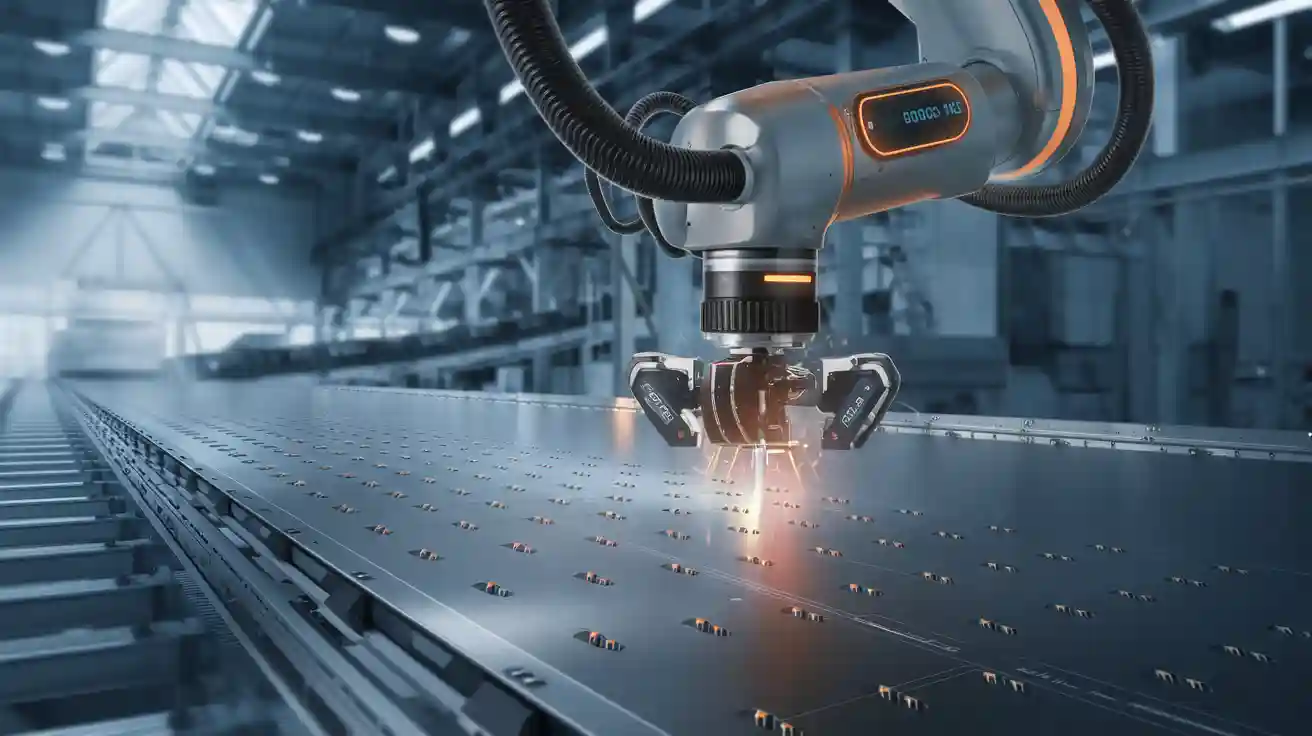How Defect Synthesis Enhances Machine Vision Technology

Defect synthesis refers to the process of creating simulated defects in images to train machine vision systems. This technique helps you improve how these systems identify and classify flaws in real-world scenarios. By using defect synthesis, you can enhance the performance of a Defect Synthesis machine vision system, making it smarter and more reliable.
This approach allows the system to detect defects with greater accuracy. It provides a broader range of examples for training, enabling the system to recognize even subtle irregularities. As a result, you achieve faster and more precise defect detection, which is essential in industries like manufacturing and healthcare.
Key Takeaways
- Defect synthesis makes fake flaws to teach machine vision systems. This helps them find real problems better.
- Using fake data improves how well defects are found. It helps industries like factories and healthcare check quality better.
- AI and image tools work together in defect synthesis. This makes finding flaws faster and more trustworthy in many areas.
- Defect synthesis saves money and reduces waste. It needs fewer real samples, so more businesses can use machine vision systems.
- The future of finding flaws depends on smarter programs and new ideas. These will make checking things even faster and more accurate.
Understanding Machine Vision Systems
Machine vision systems play a crucial role in automating tasks that require visual inspection. These systems combine hardware and software to analyze images and make decisions based on predefined criteria. To understand their functionality, you need to explore their components, operational flow, and the transformative role of artificial intelligence.
Components of Machine Vision Systems
A machine vision system consists of several essential components that work together to deliver accurate results:
- Lighting: Proper illumination ensures clear image capture, highlighting defects or features.
- Image Processing Software: This software analyzes images for tasks like defect detection and pattern recognition.
- Hardware Interfaces: These interfaces connect the system’s components, enabling seamless communication.
- Processing Units: These units handle computational tasks, ensuring real-time analysis and decision-making.
- Calibration Tools: These tools align and adjust the system for precise measurements and image quality.
- Integration and System Design: Careful planning ensures all components function harmoniously.
Each component contributes to the system’s ability to perform tasks like defect detection, object counting, and barcode reading. For example, lighting enhances image clarity, while processing units enable rapid analysis.
How Machine Vision Systems Work
Machine vision systems follow a structured process to inspect and analyze objects. First, the system captures an image using a camera. Then, it processes the image using advanced software to identify features or anomalies. Finally, it makes decisions based on the analysis, such as flagging defective items or guiding assembly operations.
Consider a typical system design: a camera portal captures images of objects on a conveyor belt controlled by a programmable logic controller (PLC). The system uses classification models to detect anomalies with high accuracy. For instance, wafer surface inspection achieves over 97% accuracy by segmenting die images and clustering features. This methodology ensures reliable defect detection, especially in industries like semiconductor manufacturing.
Role of AI in Machine Vision Systems
Artificial intelligence revolutionizes machine vision systems by enhancing their efficiency and accuracy. AI algorithms excel at detecting subtle defects and recognizing intricate patterns that traditional methods might miss. They also enable real-time decision-making, allowing you to address issues instantly.
AI-powered systems operate continuously, performing tasks faster than human capabilities. They adapt to various applications and scale with production demands. For example, AI improves defect detection accuracy, reduces waste, and lowers operational costs. These benchmarks highlight AI’s transformative impact on machine vision systems, making them indispensable in modern industries.
Defect Synthesis in Machine Vision

What Is Defect Synthesis?
Defect synthesis is the process of creating artificial defects to train machine vision systems. By simulating flaws, you can provide these systems with diverse examples, helping them recognize and classify real-world defects more effectively. This approach is especially useful when real defect samples are scarce or when you need to expand the variability of training data.
For instance, in printed circuit board (PCB) defect detection, datasets often rely on artificially synthesized defects. These synthesized defects add variability and realism to the training data, which improves the overall performance of the defect synthesis machine vision system. However, studies have shown that augmenting a small set of original defects can sometimes limit the variability within each defect class. This highlights the importance of creating realistic and diverse synthetic defects to achieve better results.
By using defect synthesis, you can train machine vision systems to detect subtle irregularities that might otherwise go unnoticed. This makes the technology more reliable and adaptable across various industries.
AI and Image Processing in Defect Synthesis
Artificial intelligence and image processing play a critical role in defect synthesis. AI algorithms analyze vast amounts of data to identify patterns and anomalies, while image processing techniques enhance the quality and accuracy of defect detection. Together, they form the backbone of a defect synthesis machine vision system.
For example, a deep Artificial Neural Network (ANN) trained on 30,000 samples of human-annotated defects demonstrates the scale of data required for effective defect detection. Similarly, the U-NET architecture has been used to process 675 simulated CT scans containing defects like pores and shrinkage. These applications show how AI and image processing work together to improve defect synthesis methods.
Machine learning algorithms also contribute to this process by enabling automatic classification and object detection. As a result, you can achieve faster and more accurate defect detection, even in complex scenarios. This combination of AI and image processing ensures that defect synthesis remains a powerful tool for enhancing machine vision systems.
Enhancing Defect Detection with Defect Synthesis
Defect synthesis significantly enhances defect detection by providing machine vision systems with a broader range of training data. When you use synthetic defects, you can simulate various scenarios and conditions, ensuring that the system is prepared for real-world challenges. This leads to improved accuracy and reliability in detecting defects.
For instance, in additive manufacturing, AI-driven defect synthesis methods have been shown to enhance detection capabilities. By training systems on extensive datasets, such as 30,000 annotated samples or hundreds of simulated scans, you can ensure that the system recognizes even the smallest flaws. This level of precision reduces errors and minimizes waste, making the defect synthesis machine vision system an invaluable asset in industries like manufacturing, healthcare, and aerospace.
Moreover, defect synthesis allows you to test and refine machine vision systems without relying solely on real-world samples. This not only saves time and resources but also accelerates the development of more advanced defect detection technologies. By leveraging defect synthesis, you can push the boundaries of what machine vision systems can achieve.
Benefits of Defect Synthesis Machine Vision System
Improved Accuracy in Defect Detection
Defect synthesis enhances the accuracy of machine vision systems by providing diverse and realistic training data. When you combine synthetic defects with real-world samples, the system learns to identify a broader range of anomalies. This approach ensures that even subtle flaws, which might otherwise go unnoticed, are detected with precision.
For example, studies comparing systems trained on real-world data versus those trained on a mix of real and synthetic data reveal significant improvements. The table below highlights these findings:
| System Type | Accuracy | Precision |
|---|---|---|
| Trained on Real-World Data | 0.57 | 77.46% |
| Combined Real and Synthetic Data | 0.60 | 82.56% |
As you can see, the inclusion of synthetic data boosts both accuracy and precision. This improvement directly impacts industries like manufacturing, where high-quality inspection is critical to maintaining product standards. By leveraging defect synthesis, you can ensure that your machine vision system delivers consistent and reliable results.
Faster Processing and Efficiency
Defect synthesis accelerates the training and operational efficiency of machine vision systems. When you use synthetic data, you reduce the time required to gather and annotate real-world samples. This streamlined process allows you to deploy systems faster and adapt them to new applications with minimal delays.
In real-time operations, machine vision systems trained with defect synthesis process images more efficiently. They can quickly identify defects, classify objects, and make decisions without human intervention. This speed is especially valuable in industries with high production volumes, such as electronics and automotive manufacturing. Faster processing not only improves productivity but also ensures that quality inspection keeps pace with production demands.
Cost Savings and Reduced Waste
Defect synthesis contributes to significant cost savings by minimizing the reliance on expensive real-world samples. Creating synthetic defects is more cost-effective than sourcing and annotating physical defects. This reduction in data collection costs makes machine vision systems more accessible to businesses of all sizes.
Additionally, improved defect detection reduces waste by identifying flaws early in the production process. When you catch defects before products reach the market, you prevent costly recalls and maintain customer trust. For instance, in industries like aerospace, where safety and quality are paramount, defect synthesis ensures that only high-quality components are approved for use. This proactive approach not only saves money but also supports sustainable manufacturing practices by reducing material waste.
Applications of Defect Synthesis in Machine Vision

Manufacturing and Quality Control
Defect synthesis has revolutionized manufacturing and quality control by improving defect detection and reducing errors. You can use this technology to train machine vision systems to identify flaws in products, ensuring higher quality standards. For instance, companies like Pepsi Co and L'Oréal have achieved remarkable results by integrating defect synthesis into their processes.
| Company | Metric Description | Improvement Rate |
|---|---|---|
| Pepsi Co | Reduced missed package defects | Up to 50% |
| L'Oréal | Decreased defects in labels and sealing integrity | 60% |
| Johnson & Johnson | Increased defect detection rates | From 75% to over 95% |
These improvements highlight how defect synthesis enhances efficiency and accuracy in quality control. By simulating diverse defect scenarios, you can ensure that your machine vision system adapts to real-world challenges, minimizing waste and boosting productivity.
Healthcare and Diagnostics
In healthcare, defect synthesis plays a critical role in diagnostics and medical imaging. You can train machine vision systems to detect abnormalities in X-rays, CT scans, and other medical images. This technology helps doctors identify diseases earlier and with greater precision. For example, synthetic data can simulate rare conditions, enabling systems to recognize them even when real-world samples are limited.
By using defect synthesis, you improve diagnostic accuracy and reduce the risk of misdiagnosis. This approach also accelerates the development of AI-driven diagnostic tools, making healthcare more accessible and efficient. Whether it’s detecting tumors or analyzing blood samples, defect synthesis ensures that medical imaging systems deliver reliable results.
Automotive and Aerospace
Defect synthesis has become indispensable in the automotive and aerospace industries, where safety and precision are paramount. You can use this technology to train systems for tasks like inspecting engine components, detecting cracks, or analyzing structural integrity. Advanced models like ECAGhostCNN achieve an impressive accuracy of 93.75% with an execution time of just 10.53ms, making them ideal for real-time applications.
- ECAGhostCNN: 93.75% accuracy, 10.53ms execution time
- CNN: 71.25% accuracy, 19.98ms execution time
- GhostCNN: 77.5% accuracy, 10.07ms execution time
- MCuePushU: 98.52% accuracy, 549ms execution time
These benchmarks demonstrate how defect synthesis enables faster and more accurate inspections. By leveraging this technology, you can enhance safety, reduce costs, and ensure compliance with industry standards. Whether it’s assembling aircraft or manufacturing vehicles, defect synthesis helps you maintain the highest levels of quality and reliability.
Challenges and Future of AI-Driven Machine Vision Systems
Current Limitations of Defect Synthesis
Defect synthesis has transformed how you train ai-driven machine vision systems, but it still faces challenges. One major limitation is the difficulty in creating synthetic defects that accurately mimic real-world flaws. When synthetic data lacks realism, it can reduce the system's ability to perform reliable visual inspection. Additionally, the variability within defect classes may be limited, which affects the system's adaptability to diverse scenarios.
Another challenge is the computational demand of generating high-quality synthetic data. Advanced image analysis software and lighting setups require significant resources, which can increase costs for smaller businesses. Privacy regulations also restrict access to real-world datasets in sensitive industries like healthcare, making it harder to validate synthetic data against real-world conditions.
Despite these limitations, ongoing research aims to address these issues by improving the realism and diversity of synthetic defects. By refining defect synthesis techniques, you can overcome these barriers and unlock the full potential of ai-driven machine vision systems.
Emerging Trends in Machine Vision Technology
Machine vision technology continues to evolve, driven by advancements in AI and data generation methods. Several trends are shaping the future of defect synthesis and visual inspection:
- Generative AI is increasingly used to create synthetic data for training models, especially in fields like healthcare where data scarcity is a concern.
- The demand for high-quality datasets is pushing industries like automotive and healthcare to adopt AI models for defect detection and diagnostics.
- Synthetic data is becoming more prevalent in scenarios where privacy regulations limit access to real datasets.
These trends highlight the growing reliance on AI to enhance real-time analysis and inspection capabilities. By leveraging these innovations, you can ensure that machine vision systems remain adaptable and efficient across various applications.
Future Innovations in Defect Detection
The future of defect detection lies in the integration of cutting-edge algorithms and experimental models. Researchers have modified the YOLOv5 algorithm to improve accuracy in detecting complex surface defects. A new detection model has also been proposed to handle intricate flaws, enhancing the reliability of ai-driven machine vision systems.
Innovations like the SPPFKCSPC module enable multiscale feature fusion, which improves real-time analysis and defect detection across diverse industries. Experimental findings show promising results, as demonstrated in the table below:
| Scheme | mAP Values | Evaluation Indices |
|---|---|---|
| 2 | Lower | Lower |
| 3 | Moderate | Moderate |
| 4 | High | High |
| 5 | Highest | Highest |
These advancements pave the way for more precise and efficient inspection processes. By adopting these innovations, you can enhance the capabilities of machine vision systems, ensuring they meet the demands of modern industries.
Defect synthesis transforms machine vision technology by enhancing its ability to detect flaws with precision. You gain access to systems that process data faster, reduce waste, and improve product quality. These benefits of ai-driven machine vision systems make them indispensable across industries like manufacturing, healthcare, and aerospace.
Looking ahead, advancements in AI and synthetic data generation promise even greater accuracy and efficiency. By adopting these innovations, you can stay ahead in a rapidly evolving technological landscape.
FAQ
What are the key components of an AI-driven machine vision system?
An AI-driven machine vision system includes cameras, lighting, image processing software, and AI algorithms. These components work together to capture, analyze, and interpret visual data for tasks like defect detection or final inspection.
How does defect synthesis improve continuous inspection applications?
Defect synthesis creates diverse training data, enabling systems to detect flaws in real-time. This improves the accuracy and reliability of continuous inspection applications, especially in industries like manufacturing and healthcare.
Can machine vision systems be used in automated automotive assembly?
Yes, machine vision systems play a vital role in automated automotive assembly. They inspect components, guide robotic arms, and ensure precision during assembly, reducing errors and improving efficiency.
Why is defect synthesis important for final inspection?
Defect synthesis enhances final inspection by training systems to recognize subtle flaws. This ensures that only high-quality products reach customers, reducing waste and maintaining brand reputation.
What industries benefit most from defect synthesis?
Industries like manufacturing, healthcare, and aerospace benefit significantly. For example, in automated automotive assembly, defect synthesis ensures precise inspections, while in healthcare, it aids in accurate diagnostics.
See Also
Investigating Flaw Identification Within Machine Vision Technologies
Ensure Flaw Detection Using Advanced Verification Vision Systems
Analyzing Defect Recognition Techniques in Vision Systems
